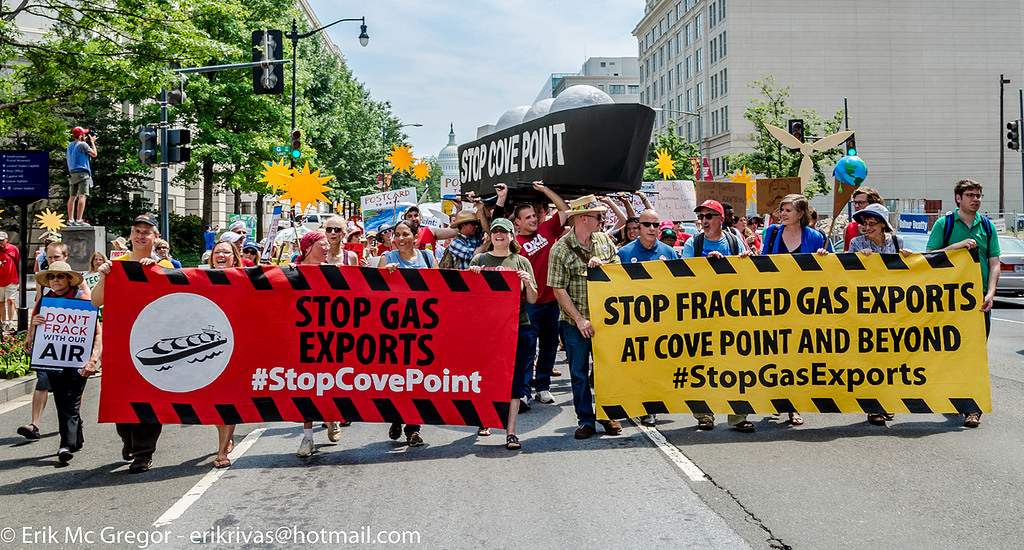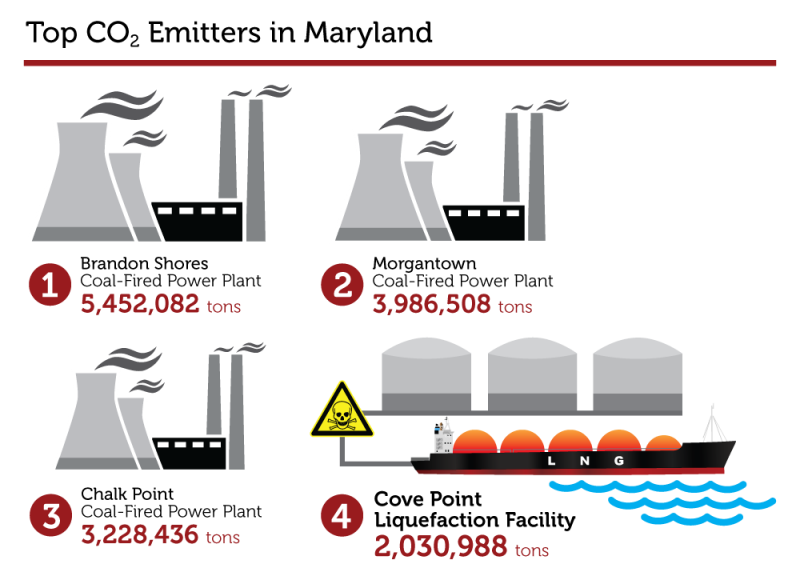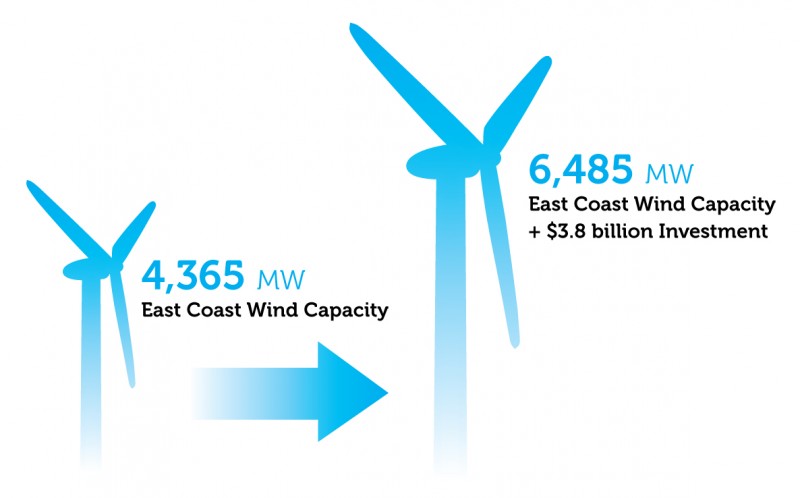
The natural gas industry is proposing a dangerous and costly detour from our region’s clean energy future: They want to build a web of fracking wells, pipelines, and processing facilities across our region in order to liquefy fracked natural gas and export it to overseas markets in Asia. The development of Cove Point, a liquefied natural gas (LNG) export facility located right on the Chesapeake Bay in Southern Maryland, is a linchpin in this plan.
Dominion’s Cove Point facility is the first LNG export terminal slated for the East Coast. It would drive demand for a surge of new hydraulic fracturing, or “fracking,” for gas in our region and require an expanding network of new fossil fuel infrastructure. While the gas industry would profit, we would pay the price of scarred landscapes, polluted air and waterways, livelihoods at risk, and worsened climate change.
Join our people-powered movement to stop a fracked gas disaster at Cove Point, and to keep our region on the path to a clean-energy fueled future.
Latest Updates
On October 31, 2016, CCAN and others filed a legal brief with the D.C. Circuit asking it to vacate the U.S. Department of Energy’s approval of Dominion Resources Inc.’s plan to export liquefied natural gas from Cove Point, arguing that the agency failed to properly study the project’s climate impacts. The Sierra Club initiated the suit, which challenges the DOE’s May 2015 decision to allow Dominion to export up to 1 billion cubic feet of gas per day from the Cove Point facility in Maryland to countries that don’t have free trade agreements with the U.S. for 20 years. CCAN joined Patuxent Riverkeeper, Potomac Riverkeeper, and Stewards of the Lower Susquehanna to weigh in with an amicus brief in support of the Sierra Club.
Exporting Fracked Gas to the World through Maryland
Dominion Energy wants Cove Point, originally built during the 1970s to import gas, to become the first liquefied natural gas export facility approved on the East Coast. The project would cost upwards of $3.8 billion dollars, require the construction of an energy-intensive plant on-site to liquefy and cool the gas, draw a surge of tanker traffic into the Bay—and enable the export of over one billion cubic feet of carbon-emitting fracked natural gas per day. The rapid expansion of fracking has led to a glut of gas in the U.S. Exporting LNG is the industry’s opportunity to drive up gas prices at home and drive up its own profits—at our communities’ expense.

The Consequences for our Communities
LNG exports will increase pollution and health risks from gas drilling, processing and transport at home, turning our communities into industrial sacrifice zones for energy being shipped elsewhere.
More Dangerous Fracking
If the Cove Point export facility is approved, it will provide a strong economic incentive for companies to expand fracking across our region, including in Maryland, where no drilling yet occurs. In other states, the expansion of fracking has caused drinking water contamination, air pollution, illnesses and even earthquakes.
Risking the Chesapeake Bay Economy and Ecology
The Chesapeake Bay supports more than a trillion dollars in economic activity through seafood and tourism. Exporting gas from Cove Point would increase traffic of massive, 1,000-foot long tankers carrying volatile, potentially explosive liquid fuel. Harmful emissions from those tankers would worsen local air quality. They would also dump billions of gallons of dirty ballast wastewater into the Bay each year. Construction of the gas liquefaction facility would require the clearing of forests and barging in of heavy construction materials along the Patuxent River, further threatening the network of rivers, wetlands and forests that attract tourists and support rare species of plants, animals and migratory birds.
A Web of Destructive Fossil Fuel Infrastructure
To support the export of LNG on the East Coast, new pipelines will be needed throughout the Marcellus shale states to get gas from new drilling wells to the export terminal. Pipelines, which inevitably leak and rupture causing dangerous explosions and fires, would snake through our waterways, backyards and farms. Noisy, polluting compressor stations could be required from Fairfax, Virginia to Frederick, Maryland and everywhere in between to keep gas moving through pipelines. Residents of the small, rural town of Myersville, Maryland are already fighting a 16,000-horsepower compressor station that Dominion wants to construct, which would be located just a mile from their elementary school.
Making Natural Gas More Expensive at Home
If all the proposed LNG export projects in the U.S. are approved, the result would be the export of more than 40 percent of our current production of natural gas. This means more competition at home, and thus, higher prices for domestic consumers and industries.

According to the NERA Economic Consulting Analysis commissioned by the U.S. Department of Energy, exporting natural gas harms every major sector of the U.S. economy, except the gas industry. In the graphic above, negative numbers represent economic loss, positive numbers equal economic gain.
The Consequences for our Climate
Cove Point is our region’s line in the sand on climate change. Looking at the big picture impacts of fracking, the International Energy Agency concludes that a worldwide reliance on fracked gas would lead to six degrees Fahrenheit of atmospheric warming, in other words, cooking the planet. LNG exports are even more energy intensive than gas drilled and burned at home. After the gas is transported, liquefied for export and then re-gasified to burn, the lifecycle emissions of exported LNG are 15 percent higher than gas consumed domestically. To power liquefying and cooling operations, Cove Point would require construction of a new gas plant on-site that would be Maryland’s fourth-largest climate polluter. From start to finish of the LNG export process, Cove Point would trigger more planet-heating pollution than Maryland’s entire fleet of seven coal-fired power plants combined.
If we’re going to preserve a safe climate, we can’t open the floodgates to fracked gas exports on the East Coast—just like we can’t build the Keystone XL tar sands oil pipeline to the Gulf Coast or new coal export terminals on the West Coast. We can and must invest instead in clean energy, making our region a leader in offshore wind power, new solar installations and energy efficiency, technologies that will create jobs and grow our economy permanently and safely.
Resources
- Watch: Video from the Stop Gas Exports rally, July 13th, 2014
- Fact sheet: Get the facts on the dangers of fracked gas exports at Cove Point versus the benefits of expanding Maryland’s clean energy supply.
- Fact Sheet: Get the facts on how the proposed Cove Point LNG export facility threatens southern Maryland.
- Fact Sheet: Answering Questions about Liquefied Natural Gas (LNG) – by Americans Against Fracking, April 2014
- Read the Politico op-ed on Cove Point by 350 co-founder Bill McKibben and CCAN director Mike Tidwell. Learn how the Cove Point fight leads directly to President Obama, and get the facts on why Dominion’s plan is “radical and absurd on its face, benefits no one in the long run but the super-rich fossil-fuel industry and does real harm to an already ailing global climate.”
- Letter to President Obama: Read the letter sent from 16 national environmental groups to President Obama, calling on him to reverse course on U.S. exports of fracked and liquefied natural gas and, as a first step, ensure a full Environmental Impact review of Cove Point.
- Download a map of Maryland Gas Basins according to the U.S. Geological Survey.
- Infographic: See how the LNG processing plant proposed for Cove Point would be Maryland’s fourth largest climate polluter.
- Lifecycle greenhouse gas emissions analysis: View the (PDF) presentation on the lifecycle greenhouse gas impact of Cove Point LNG exports vs. coal, showing Cove Point would trigger as much or more lifecycle greenhouse gas pollution than all seven of Maryland’s coal-fired power plants combined. Click here to view a related summary of recent studies on climate-harming methane leakage from the gas production process.
- Summary of DOE report: Study confirms that U.S. LNG exports to Asia will be WORSE than coal for the atmosphere. Click here to see the related breakdown of known LNG export contracts, showing fracked gas exports will mostly go to Asia.
- Dominion Study Confirms Climate Risks of Lifecycle Methane Leakage from Exporting Liquefied Natural Gas
- Dominion Fracked Gas Facility Explosion: Get the facts about the as-yet-unexplained explosion at the Dominion Blue Racer facility in West Virginia. Why did a Dominion fracked gas facility explode this past September? Environmental health, community and faith groups demand answers.
- Read CCAN’s response letter refuting Dominion’s claims.
- Baltimore Sun editorial: “Cove Point deserves closer examination,” 12/2/2013
- Washington Post op-ed: Read CCAN Director Mike Tidwell’s breakdown of the climate consequences of Dominion’s LNG export plan.
- Baltimore Sun op-ed: Read CCAN Chief Policy Analyst James McGarry’s summary of why fracked gas exports are a bad deal for Marylanders.
- Polling data: See the results of statewide polling showing that 81 percent of Maryland voters believe that a full federal environmental impact statement should be required for the proposed fracked gas export facility at Cove Point.
- Learn more: Read more about the threat of U.S. LNG exports from the Sierra Club.
- Press Release: Groups Appeal Federal Approval of Cove Point Fracked Gas Export Facility
- Follow updates from Calvert Citizens for a Healthy Community on Facebook.
- Follow updates from the new “We Are Cove Point” campaign, of which CCAN is a member.
- Press Release: In First Step of Legal Battle, Groups Challenge cove Point LNG Export Project’s Federal Approval.
- Watch: Video of safety risks associated with Cove Point.
- Press Release: Federal Regulators and Elected Officials declared ‘guilty’ on Gas Exports.
- Press Release: Calvert Citizens for a Healthy Community responds to federal ruling on Cove Point.

